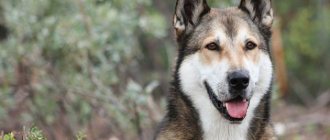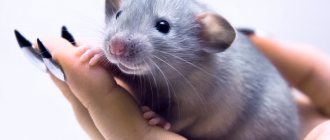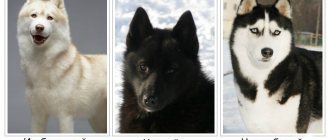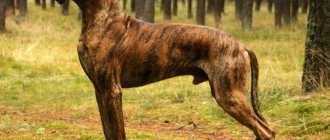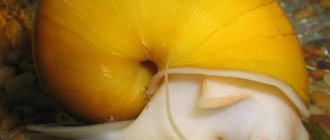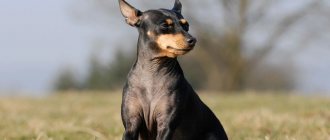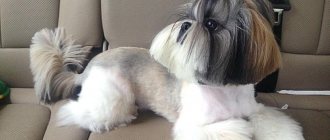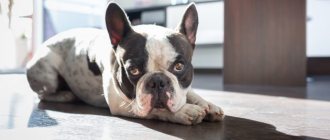- Pets
- >>
- Dog breeds
* Here is a photo of a typical representative of the Giant Schnauzer dog breed . You can send us photos of your animals by email, and we will post them on the website. Don't forget to send your pet's name.
Other breed names:
Giant Schnauzer
Video
* We invite you to watch a video about the Giant Schnauzer . In fact, in front of you is a playlist in which you can select and watch any of 20 videos about a given dog breed by simply clicking on the button in the upper right corner of the window. In addition, the material contains quite a lot of photos. By looking at them you can find out what a Giant Schnauzer looks like.
In this article:
|
Rate the material!
[Total votes: 1 Average: 5]
The Giant Schnauzer is an intelligent and efficient dog. Thanks to this, dogs often serve as police officers, bloodhounds, security guards - they have mastered many other professions. But they have a strong character and you need to find an approach to them, so as pets they are suitable only for those owners who want to have an independent dog.
History of the origin of the Giant Schnauzer
It is believed that they, like most other wire-haired breeds, are descended from herding dogs. The ancestors of the Giant Schnauzers lived in the south of Germany and were used not only as shepherds, but also guarded the houses and the owners themselves.
It is not entirely clear how closely related they are to the Schnauzers; it is known that they are related to pinschers - but at what point it appeared is no longer clear.
In the 19th century, Giant Schnauzers gradually ceased to be only peasant dogs. This is clearly evidenced by the fact that they can increasingly be seen in portraits of aristocrats of those times - by that time the breed was already taking shape in its main features. At the beginning of the 20th century, they began to participate in exhibitions, and international interest appeared in the breed.
Then they were called beer schnauzers due to the fact that the owners of Bavarian taverns often assigned them to carts with beer as guards. They were also sometimes called bear schnauzers, probably because they were used to hunt bears.
In those days, the formation of the breed was still ongoing: its representatives were very different from each other in size and color: they could be yellow, gray, black and white. In 1923, a standard for the appearance of the breed was developed, and with it its current name arose. At the same time, the first Giant Schnauzers appeared in the USSR, but at first they did not gain popularity.
Interesting fact: Most of the modern Russian Giant Schnauzers descended from two individuals brought to the Krasnaya Zvezda kennel in the early 1970s. In this kennel, work was carried out to improve the breed through crossing with dogs imported from Germany and the Czech Republic.
As a result, domestic Giant Schnauzers have good character and appearance, and are able to compete at international exhibitions. They are not among our most popular breeds, but they are quite common.
Giant Schnauzer - description of the breed
These are strong, fit dogs, the largest of the schnauzers. The height of an adult dog should reach 60-70 cm, and weight – 35-47 kg.
Breed standards:
- Large oblong skull, flat forehead, clearly defined transition to the muzzle;
- The jaws are large, 42 teeth, scissor bite;
- The ears are set high and slightly drooping. Previously, it was customary to stop them, now in Europe this procedure is prohibited, in Russia it is still often performed;
- The neck is muscular and wide, without folds;
- The back is short and powerful, the belly and sides are tucked in, making the Giant Schnauzer look slender. The croup is slightly sloping, protruding chest;
- The limbs are straight and parallel, set quite widely. The shoulder blades are inclined at an angle of 50°. Both hind and forelimbs should be sufficiently long and well developed, with cat-type paws. When moving, the forelimbs are thrown far forward, and momentum is imparted with the help of the hind limbs. The dog's movements are sweeping;
- The tail is short, raised, tapering towards the end. In Russia it is often stopped;
- The coat is very hard and short. The fur that grows on the muzzle is the most rigid. The undercoat is abundant.
Every deviation from the approved breed standards is considered a defect. Most are not too significant unless the dog has too many of them.
But there are also defects - these include severe defects and the following deviations:
- Malocclusion;
- Deviation in height of more than 4 cm from standards;
- Inconsistency with the breed;
- Deviations in behavior - cowardice, aggression, malice, excessive distrust.
Giant Schnauzer (Risenschnauzer)
TRANSLATION: Kuznetsova Ekaterina Vladimirovna COUNTRY OF ORIGIN: Germany PUBLICATION DATE OF THE CURRENT STANDARD: 04/06/2000 USE: guard and companion dog CLASSIFICATION: Group II Pinscher and Schnauzer - Molossians, Swiss Mountain, Cattle Dogs and other breeds Section 1: Pinschers and Schnauzers C testing of working qualities BRIEF HISTORICAL SUMMARY: At the very beginning, the Giant Schnauzer was used in the south of Germany as a pack animal driver and livestock guard. Since 1913, this breed has been included in the Book of Breeding and in 1925 it was recognized as a working dog. GENERAL APPEARANCE: Large, strong, compact rather than graceful, with a hard, wiry coat, agile and energetic. A dog that has all the characteristics of a protector, whose appearance inspires a sense of respect. IMPORTANT PROPORTIONS: Square format, height at the withers is directly proportional to the length of the body. The ratio of the length of the head (from the tip of the nose to the occipital protuberance) and the length of the topline (from the withers to the base of the tail) is approximately 1:2. TEMPERAMENT/BEHAVIOR: Typical characteristics of this dog are its excellent balanced temperament and unique devotion to its owner. The Giant Schnauzer has very well developed senses. He is prudent, diligent, strong, persistent, has very good immunity and adapts well to a new climate. His natural self-confidence, poise and stamina make him an excellent sporting, working, service and companion dog. HEAD CRANIAL REGION Skull: strong, oblong, occipital protuberance not very pronounced. The head size corresponds to the overall size of the dog. The forehead is flat, parallel to the bridge of the nose, without wrinkles. The transition from the forehead to the muzzle (“stop”) is well defined and emphasized by bushy eyebrows. FACIAL REGION Nose: the nose is large, well developed, always black. Muzzle: Wedge-shaped, tapering evenly from the eyes to the nose. The bridge of the nose is straight. Lips: black, tight, dry. Jaws and teeth: The upper and lower jaws are strong. Scissor bite, teeth are clean, white, in full set (42 teeth according to the dental formula), well connected. The muscles of the lower jaw and cheekbones are very well developed, but should not interfere with the rectangular shape of the head, including the beard. Eyes: medium size, oval, straight set, dark, with a lively expression. The eyelids are dry and tight-fitting. Ears: high set, hanging on cartilage, in the shape of the letter “V”; The corners of the ears are adjacent to the cheekbones. The ear set is symmetrical; they are directed forward. The fold lines are parallel and located at the level of the top line of the skull. NECK: The back of the head is strong, muscular and slightly arched. The neck is powerful, proportional to the dog’s body, wide, harmoniously flowing into the withers, with good projection, which gives it elegance. The skin on the throat is well stretched, dry, without dewlap. BODY Topline: Slightly sloping from the withers to the base of the tail. Withers: is the highest point of the dog's body. Back: strong, durable, short. Loin: short, strong. The short distance between the last rib and the hip gives the dog a compact appearance. Croup: Slightly rounded towards the base of the tail. Chest: Moderately broad, oval in shape, deep, reaching the elbows when viewed in profile. The chest bone protrudes forward beyond the line of the shoulder joint. Belly: Moderately tucked up and forms a beautiful curved line along the entire body of the dog. Tail: natural, not docked. FOREQUARTERS When viewed from the front, the forelegs are straight and parallel, not too close to each other, the forearms are straight. Shoulders: flat, with well-developed elastic muscles, due to which they protrude above the spine in the thoracic region, and are set at an angle of 50 degrees relative to the horizon. Shoulder: The humerus bones fit tightly to the body, with well-developed muscles, forming an angle of approximately 95-105 degrees in relation to the shoulder blades. Elbows: tightly pressed to the chest, not turned outward, but not tucked under. Forearms: When viewed from any side, straight, well developed, muscular. Wrists: strong and durable, standing out slightly against the background of the forearms. Pasterns: straight, vertical when viewed from the front; in profile – slightly inclined; strong and elastic. Paws: short and rounded, toes collected in a dense ball (“cat’s paw”), claws short, dark; Paw pads are hard. HINDQUARTERS When viewed in profile, they are located at an angle; when viewed from the front, they are straight, parallel, and not too close to each other. Thigh: Moderately long, broad, strong and muscular. Knee: neither turned out nor in. Lower legs: long and strong, sinewy, leading into strong hocks. Hock joint: strong, stable, well angulated, neither turned out nor in. Hocks: Short, perpendicular to the ground. Paws: toes short, gathered into a tight ball; claws black, short. MOVEMENT: Elegant, graceful, light, free, sweeping. The forelimbs are thrown forward as far as possible, and the hind limbs provide them with the necessary push. The front leg on one side and the back leg on the other begin to move forward at the same time. The back, joints and ligaments are strong in movement. SKIN: Tightly fitting all over the body. COAT: hard, wiry, dense. It consists of an inner layer - thick undercoat and outer, guard hair, tightly fitting throughout the body, of medium length. The guard hair is coarse and hard, should be of sufficient length to allow its structure to be determined, and not tousled or wavy. The fur on other parts of the body may have a less coarse texture. The hair on the forehead and ears is slightly shorter than on the body. A typical feature of the breed is considered to be longer hair on the face, in the form of a beard and shaggy eyebrows, slightly hanging over the eyes. COLOR: Pure black with black undercoat Pepper and salt When breeding pepper and salt dogs, you should aim for an intensely pigmented pepper color, evenly distributed throughout the coat with a gray undercoat. All shades of “pepper and salt” from dark steel to silver are acceptable. Regardless of the shade, the dog must have a dark mask on the face, emphasizing the expression of the muzzle and the color of which should be harmoniously combined with the color of the dog as a whole. White spots on the head, chest or legs are undesirable. HEIGHT AND WEIGHT Height at withers: Males and females: from 60 to 70 cm Weight: Males and females: from 35 to 45 kg FAULTS: Any deviations from the above points are considered as shortcomings or defects depending on the degree of their severity. In particular: A head that is too small or too short A round or heavy skull Wrinkles on the forehead A short, pointed or wide muzzle Overbite Round, too large or light-colored eyes Ears that are too long or low set. Asymmetrical ear set Too much prominent cheekbones or zygomatic arches “Raw” skin on the neck, dewlap Weak, thin neck Too long, convex or “soft” back Humpbacked back Sloping croup Tail set with a slope from its base towards the head Too long legs Ambling too much short or too long, fine, wavy, tousled, white or spotted coat. Brown undercoat. In the “pepper and salt” color there is a black “belt” on the back or a black saddle. Deviations in height up to 2 cm in one direction or the other SERIOUS DISADVANTAGES: Rough or light build, short or long legs “Male” type for females and “bitch” type for males Turned elbows Barrel-shaped hind limbs Deviations in height from 2 to 4 -x cm in one direction or the other. DISQUALIFYING VICES: Cowardly, aggressive, angry, nervous behavior. Excessive distrust. Deformities of any type Insufficient breed type Bite defects: undershot, overshot, misalignment of the jaw Gross defects in individual parts, such as defects in build, coat and color Deviations in height by more than 4 cm in one direction or another Any dog with obvious physical or behavioral deficiencies should be disqualified. Note: Males must have two normally developed testes, fully descended into the scrotum.
Popular colors of Giant Schnauzers
Two colors are recognized as standard for the breed:
- Completely black;
- Pepper and salt.
They are regulated, details such as shades, depth, halftones, and so on are clearly established. At the same time, with the first color, everything is relatively simple: the coat and undercoat should be black. Experts evaluate the depth of color and the absence of tan, “rusty” undercoat, spotting, and the like.
If none of these are present, the dog meets the standards. Over time, gray hair appears - its suitability for the age of the animal is also assessed. Black color is quite easy to evaluate; salt and pepper is a completely different matter. Gray Giant Schnauzers are very difficult to evaluate; many articles are devoted to this problem.
At first, it may seem that such dogs are simply ash-gray, and the inclusions of white in the coat are evenly distributed, and there are no other peculiarities in the color. But this is not so: with visible chaos, dark and white hairs are located in certain zones, which must be at the correct distance from each other.
This is what allows you to get the effect of uniform color, pleasing to the eye. There are also frequent deviations in which light and dark spots on the coat are easily distinguishable. There should not be such spots, and in addition to uniformity, there are other requirements for color: the ash tone should be intense, and the undercoat should be light pepper, with a soft accent.
Variations of color are possible, from dark steel to light silver, all of them are recognized as the standard. Giant Schnauzers should always have a dark mask on their face.
Breed standard
The FCI standard[1] defines the following requirements for the Giant Schnauzer:
Usage:
guard and companion dog, police working dog, bloodhound
Classification:
Group II Pinscher and Schnauzer - Molosser, Swiss Mountain, Cattle Dogs and other breeds Section 1: Pinschers and Schnauzers With testing of working qualities
General form:
large, strong, compact rather than graceful, with a hard, wiry coat, agile and energetic. A dog that has all the characteristics of a protector, whose appearance inspires a sense of respect.
Important proportions:
Square format, the height at the withers is directly proportional to the length of the body. The ratio of the length of the head (from the tip of the nose to the occipital protuberance) and the length of the topline (from the withers to the base of the tail) is approximately 1:2.
Temperament/behavior:
Typical features of this dog are its excellent balanced temperament and unique devotion to its owner. The Giant Schnauzer has very well developed senses. He is prudent, diligent, strong, persistent, has very good immunity and adapts well to a new climate. His natural self-confidence, poise and stamina make him an excellent sporting, working, service and companion dog.
Head
Cranial region
Skull: strong, oblong, occipital protuberance not very pronounced. The head size corresponds to the overall size of the dog. The forehead is flat, parallel to the bridge of the nose, without wrinkles. The transition from the forehead to the muzzle (“stop”) is well defined and emphasized by bushy eyebrows.
Facial area
- Nose: the nose is large, well developed, always black.
- Muzzle: Wedge-shaped, tapering evenly from the eyes to the nose. The bridge of the nose is straight.
- Lips: black, tight, dry.
- Jaws and teeth: The upper and lower jaws are strong. Scissor bite, teeth are clean, white, in full set (42 teeth according to the dental formula), well connected. The muscles of the lower jaw and cheekbones are very well developed, but should not interfere with the rectangular shape of the head, including the beard.
- Eyes: medium size, oval, straight set, dark, with a lively expression. The eyelids are dry and tight-fitting.
- Ears: high set, hanging on cartilage, in the shape of the letter “V”; The corners of the ears are adjacent to the cheekbones. The ear set is symmetrical; they are directed forward. The fold lines are parallel and located at the level of the top line of the skull.
Giant Schnauzer on a 1976 GDR postage stamp.
Neck:
The back of the head is strong, muscular and slightly arched. The neck is powerful, proportional to the dog’s body, wide, harmoniously flowing into the withers, with good projection, which gives it elegance. The skin on the throat is well stretched, dry, without dewlap.
Frame
- Topline: Slightly sloping from withers to base of tail.
- Withers: is the highest point of the dog's body.
- Back: strong, durable, short.
- Loin: short, strong. The short distance between the last rib and the hip gives the dog a compact appearance.
- Croup: Slightly rounded towards the base of the tail.
- Chest: Moderately broad, oval in shape, deep, reaching the elbows when viewed in profile. The chest bone protrudes forward beyond the line of the shoulder joint.
- Belly: Moderately tucked up and forms a beautiful curved line along the entire body of the dog.
- Tail: natural, not docked.
Forelegs
When viewed from the front, the forelegs are straight and parallel, not too close to each other, and the forearms are straight.
- Shoulders: flat, with well-developed elastic muscles, due to which they protrude above the spine in the thoracic region, and are set at an angle of 50 degrees relative to the horizon.
- Shoulder: The humerus bones fit tightly to the body, with well-developed muscles, forming an angle of approximately 95-105 degrees in relation to the shoulder blades.
- Elbows: tightly pressed to the chest, not turned outward, but not tucked under.
- Forearms: When viewed from any side, straight, well developed, muscular.
- Wrists: strong and durable, standing out slightly against the background of the forearms.
- Pasterns: straight, vertical when viewed from the front; in profile - slightly inclined; strong and elastic.
- Paws: short and rounded, toes collected in a dense ball (“cat’s paw”), claws short, dark; Paw pads are hard.
Hind limbs
When viewed in profile, they are located at an angle; when viewed from the front, they are straight, parallel, and not too close to each other.
- Thigh: Moderately long, broad, strong and muscular.
- Knee: neither turned out nor in.
- Lower legs: long and strong, sinewy, leading into strong hocks.
- Hock joint: strong, stable, well angulated, neither turned out nor in.
- Hocks: Short, perpendicular to the ground.
- Paws: toes short, gathered into a tight ball; claws black, short.
Movements:
Elegant, graceful, light, free, sweeping. The forelimbs are thrown forward as far as possible, and the hind limbs provide them with the necessary push. The front leg on one side and the back leg on the other begin to move forward at the same time. The back, joints and ligaments are strong in movement.
Leather:
tightly fitting throughout the body.
Wool:
hard, wiry, dense. It consists of an inner layer - a thick undercoat and an outer, guard hair, tightly fitting throughout the body, of medium length. The guard hair is coarse and hard, should be of sufficient length to allow its structure to be determined, and not tousled or wavy. The fur on other parts of the body may have a less coarse texture. The hair on the forehead and ears is slightly shorter than on the body. A typical feature of the breed is considered to be longer hair on the face, in the form of a beard and shaggy eyebrows, slightly hanging over the eyes.
Pepper and salt color
Color:
- Pure black with black undercoat.
- Pepper and salt.
When breeding pepper and salt dogs, you should aim for an intensely pigmented pepper color, evenly distributed throughout the coat with a gray undercoat. All shades of “pepper and salt” from dark steel to silver are acceptable. Regardless of the shade, the dog must have a dark mask on the face, emphasizing the expression of the muzzle and the color of which should be harmoniously combined with the color of the dog as a whole. White spots on the head, chest or legs are undesirable.
Height and weight:
Height at withers: Males and females: from 60 to 70 cm
Weight: Males and females: from 35 to 47 kg[2].
Flaws:
Any deviations from the above points are considered as shortcomings or defects depending on the degree of their severity. In particular: A head that is too small or too short A round or heavy skull Wrinkles on the forehead A short, pointed or wide muzzle Overbite Round, too large or light-colored eyes Ears that are too long or low set. Asymmetrical ear set Too much prominent cheekbones or zygomatic arches “Raw” skin on the neck, dewlap Weak, thin neck Too long, convex or “soft” back Humpbacked back Sloping croup Tail set with a slope from its base towards the head Too long legs Ambling too much short or too long, fine, wavy, tousled, white or spotted coat. Brown undercoat. In the “pepper and salt” color there is a black “belt” on the back or a black saddle. Deviations in height up to 2 cm in one direction or another
According to the breed standard, serious deficiencies:
Rough or light build, short or long legs. “Male” type for females and “bitch” type for males. Twisted elbows. Barrel-shaped rear legs. Deviations in height from 2 to 4 cm in one direction or another.
Disqualifying faults:
Cowardly, aggressive, angry, nervous behavior. Excessive distrust. Deformities of any type. Insufficient breed type. Bite defects: undershot, overshot, jaw misalignment. Gross defects in individual articles, such as defects in conformation, coat and color. Deviations in height of more than 4 cm in one direction or another. Any dog exhibiting obvious physical or behavioral defects shall be disqualified.
Note: Males must have two normally developed testes, fully descended into the scrotum.
Character and habits of Giant Schnauzers
The main feature of representatives of the Giant Schnauzer breed is that they are true service dogs with a developed protective instinct. Therefore, while protecting the owner, they can be aggressive, but in the family circle they are very kind, especially with children. Still, the Giant Schnauzer recognizes only one person as its owner, and he will have to keep the pet strict at all times.
You can’t let him go: be sure to constantly remind him that he needs to eat, walk and sleep by the hour, otherwise the pet will become stubborn in other cases. He needs to be trained, and not to stop teaching new commands from time to time. You should communicate with him more often and simply.
They treat strangers with suspicion and are ready to attack even those who simply raise their voice at the owner. At the same time, they remember faces well and even recognize people whom they had previously seen only once and a long time ago. Those to whom the owner is clearly well disposed get used to very quickly.
Interesting fact: Training of Giant Schnauzers should be aimed at making them more obedient and restrained, and curbing their aggression. They learn with ease, but they tend to test the strength of the teacher, so at first they are often stubborn.
A Giant Schnauzer will only respect an owner who shows himself to be a real leader in his eyes, but who is capable of much with him. Still, you should not expect that after a period of training the dog will turn into a simple executor of the owner’s will: it will be stubborn from time to time all its life, and it will also need to be trained all its life.
It’s not because Giant Schnauzers are stupid, quite the opposite – they are very smart dogs, which is why they tend to doubt some commands. In addition, they often show cunning and may try to deceive their owner. To prevent this and interact well with your pet, you need to constantly communicate with him.
They communicate well with children and enthusiastically participate in children's games. Of course, it is undesirable to pull their beard once again, but a well-bred representative of the breed will not do anything even to a child who has decided to test his coat for strength. But adult dogs that have not interacted with children before may be an exception, so you should be careful with them.
Character and behavior
The standard describes the Giant Schnauzer as a balanced dog, loyal to its owner, easy to train, fast and resilient, with an innate ability to endure stress, calm self-confidence and strong leadership abilities. All these qualities make him an excellent companion, sports and service dog. But in order for the Giant Schnauzer to grow up the way it is described, you need to invest a lot of time and effort into raising the puppy.
The Giant Schnauzer is intelligent, patient and adapts well to its environment. Very curious and smart. Sometimes incredibly cunning and stubborn. Loyal to his owner, affectionate and friendly to other family members. With proper socialization, he gets along well with children of all ages. Very sensitive to affection and care, they need constant communication. May be offended by rudeness. It has an innate protective instinct and pronounced territoriality. They are wary of strangers, but at the same time, they can almost always distinguish an enemy from a friend. Barks only when they feel threatened, not paying much attention to random extraneous noises. The owners note that Rizens are very sincere dogs with an almost human look. They are sensitive, reliable, loyal and communicative.
Giant Schnauzers usually get along well with other pets, especially large ones. Sometimes they can show jealousy. It is important for owners to know that these dogs have a strong hunting instinct, which can cause harm to small animals, birds or cats.
Interesting facts about Giant Schnauzers
Schnauze is translated from German as muzzle, and riese means big. Thus, the name of the breed can be translated as “big muzzle”. Giant Schnauzers are very smart, which helps in their training: after training, they can recognize gestures and remember their meaning, and easily learn commands. In an emergency situation, they can sometimes figure it out and begin to act much faster than a person - which is why rescuers value them so much.
Giant Schnauzers make excellent crime hunters and search engines, which is why they often serve in government departments in different countries. They are also in the civil service in Russia, albeit in much smaller numbers than German shepherds: they are in the army, police, Ministry of Emergency Situations - and everywhere they receive praise.
The ingenuity of these dogs can also be used in everyday life: they will gladly take children on a sleigh ride, which will also be entertainment for the dog, or carry out some other errands around the house. You can accustom a Giant Schnauzer to many tasks: for example, in one Russian family they trained their pet to carry water from the pump to the house. People's Artist of the USSR Yuri Nikulin was a big fan of the breed and kept two Giant Schnauzers at home.
Giant Schnauzers are one of the most numerous participants in the Schutzhund competitions held in Germany, with their help the working qualities of dogs are tested. As part of such a competition, they must first find the intruder, report him by barking, but not bite; if he tries to escape, stop him.
Pros and cons of Giant Schnauzers
Dogs of this breed have many advantages, which is why they are bred.
Let us highlight the most important of them:
- Intelligence and intelligence - thanks to their quick wits, they learn quickly, they don’t have to be told repeatedly not to do something. They understand the mood of the owner and do not bother him when he is not in the mood for communication;
- The qualities of a watchman and protector provide protection for both the owner and his property, and you can be sure that the Giant Schnauzer will try to fulfill its mission with all its might;
- Balanced – if a dog of this breed is well trained, it will not react to everything and will only attack those who truly pose a threat. When surrounded by family, he behaves calmly and even friendly, and quickly recognizes familiar family members;
- Friendly attitude towards children - understands well how children differ from adults, and allows them much more, does not respond with aggression to their antics. But it is worth noting that it is still better not to leave Giant Schnauzers alone with too young children, even well-trained ones - they can cause injury by accident;
- Loyalty - despite the fact that they can show character to the owner and be stubborn, even try to outwit him, and are not too inclined to flatter, they are very attached to the owner;
- Efficiency - thanks to the combination of strength and intelligence, they are able to perform various, even quite complex work, and show excellent results in difficult conditions;
- The ability to adapt - they can be kept both on the street and in an apartment, and in the second case they will remain healthy and vigorous, provided that they are walked often enough and for a long time. They behave calmly in the apartment.
The breed also has disadvantages:
- Like other guard dogs, Giant Schnauzers are quite aggressive, so they need to not only be trained, but also be kept under strict control at all times. In addition, the breed is also distinguished by its stubbornness and cunning, so such a pet will not allow the owner to relax - he will have to show his authority all the time;
- This dog's coat will require constant care, so be prepared to devote quite a lot of time to it;
- When living in an apartment, you will need to spend at least two hours walking every day, and they must be very active, so the owner will not be able to take a relaxing walk - this should be jogging or cycling.
Temperament and intelligence
These dogs are intelligent and easy to train. Reviews about the character of the Giant Schnauzer are only positive. Not only do they serve well, but they are also good partners for their owners and are extremely loyal to them.
We should not forget that these dogs have well-developed hunting instincts. Therefore, when walking a dog can get carried away with hunting and get lost.
Sometimes Giant Schnauzers pose demonstratively and attract attention. This is one of the hallmarks of their character.
Dogs of this breed are indispensable as play partners with children and are very tolerant of the fun of children. For very young children they become caring nannies. These dogs are tolerant of other animals kept in the house. Very strong bonds can occur if animals grow up together.
Note!
Nicknames for dogs for boys - easy, rare and most beautiful names for dogs in alphabetical order
Nicknames for girls' dogs - a list of beautiful, funny, unusual nicknames for large and small dog breeds
Maltipoo dog - everything about the dog from A to Z. Photos, description of the breed, character, maintenance features, prices, reviews
Like other dogs, Giant Schnauzers must be trained and disciplined from an early age. Otherwise, mental deviations in the form of unmotivated aggression, anxiety, self-will and cowardice are possible.
Breeding Giant Schnauzers
If you are the owner of a male dog, you should immediately decide whether you will breed him. For the dog himself whether they exist or not is not so important. If you walk your pet often and exercise it, then there will be no problems even if there are no matings. Therefore, the key factors here are: how much demand he has, whether he has success at exhibitions, whether his nervous system is stable, and the like.
It is more difficult for owners of bitches, because when puppies appear, they will face many new problems. There are often many puppies in a litter - up to 10-12, you need to take into account that all of them will need a lot of space, as well as funds for food and medications. Puppies will need to be kept for at least one and a half months, and some often stay for up to 3-4 months.
It will be much more difficult for beginners to place puppies than for experienced breeders with a reputation, especially if they choose owners and not give them away to just anyone. Puppies grow quickly and, if the adult Giant Schnauzers behave calmly in the house, the young ones play and frolic - and with each week their games become more and more destructive for the home.
On the other hand, this can also be an opportunity to earn money, but only if both parents meet all breed standards and the mating is registered - you won’t get much for puppies from an unregistered mating.
Bitches come into heat once, or more often twice, a year. You can tell about its imminent onset by the changed behavior of the pet: within a week or two there is a decrease in performance, absent-mindedness, and she marks her territory more often.
Mating is carried out twice with an interval of one and a half to two days. Pregnancy lasts two months or a little longer. Typically, with more puppies, the gestation period is shorter. The approach of childbirth is indicated by the dog's search for a secluded place for birth. It is better if the owner prepares it himself.
This should be a draft-free place, calm, warm and shaded. During the first birth, it is worth staying close to the dog in case of complications. If the process takes longer than an hour, and you have little experience, you need to call a veterinarian.
Caring for Giant Schnauzers
You can keep a Giant Schnauzer both in a private house and in an apartment. Of course, the first option is preferable, but a dog can only live outside when it’s warm. It is also important that they are not kept in closed enclosures, much less on a chain. The best option: an outdoor enclosure with a canopy and a booth inside.
During the winter, you can leave your pet outside only if there is heating, otherwise you need to take him into the house. Even in the warm season, it is better to take dogs over 8 years of age home at night, except during the hottest weeks - otherwise they will get colds in their kidneys or joints.
Interesting fact: Although Giant Schnauzers are large, they do not take up much space in the house and are not inclined to frolic too much, turning everything around: you just need to provide them with a quiet corner and regular walks. This item is mandatory for dogs living in the house; walks must be carried out at least twice a day and be long enough.
For puppies this is at least half an hour, for adult dogs an hour, or better yet two. During walks, they need to be let off leash in deserted places so that they can run around calmly. Walks should be as vigorous as possible; a slow pace will not suit the dog, so it makes sense to take a scooter or bicycle.
They also need training - because of this, it is better to keep dogs of this breed for people who are full of energy; for the elderly, they can turn into a burden. Moreover, the Giant Schnauzer also needs other care, primarily for its coat. It will need to be combed every day and cut every two months.
A well-groomed coat should not have a characteristic dog odor - if it is present, then you need to take better care of it. Trimming is mandatory so that hair does not fly around the apartment after shedding, and after the shedding hair is removed, you need to treat damage to the skin with chlorhexidine.
Trimming should be done for the first time at 6 months, and then every six months. For washing, use tar or sulfur shampoo; this can be done not very often, if necessary. After the dog eats, you need to wipe the hair on its face, and if it is oily, then wash it with soap - this minimizes the risk of the fungus spreading.
If your pet is accustomed to swimming, then before the start of the season he needs to be vaccinated against fungus and also start using antifungal shampoo. Ears, nose, teeth, claws and eyes are taken care of as usual. It will be useful to pluck the hair growing in the ear funnel so that it does not collect wax.
Care and maintenance
You can keep a dog in an apartment (with personal space provided) and a country house (in an insulated enclosure). In severe frosts, it is forbidden to keep the dog outside, as the undercoat will not protect him from the cold. It is also prohibited to put the dog on a chain.
It is necessary to periodically treat your pet with parasite repellents and undergo regular vaccinations. The fur around the eyes, ears and on the pads of the paws must be trimmed. The eyes and nose should be cleaned. After water procedures, remove excess moisture and accumulated dirt from the ears. Once every six months, show the dog to an ophthalmologist. Trim the claws with a nail clipper. It is important to walk your dog daily and give him physical activity to keep fit.
If you bought a dog for breeding, you should know that the first mating should occur no earlier than 18 months. Bitches begin to go into heat at 6 months, but the body may not tolerate childbirth.
Feeding
It is advisable to feed your pet 2-3 times a day. An adult dog needs approximately 1 kg of meat and 300 g of dry food every day. Since it is not possible to independently prepare a completely balanced food for a Giant Schnauzer, experts recommend purchasing ready-made products for large, athletic breeds. Dogs are prone to overeating; it is necessary to carefully calculate the portion (take into account weight by month). As a rule, the dosage is indicated on the food packaging and takes into account the dog’s weight. It is easy to understand whether your pet has enough food: its ribs should not be visible, but they can be felt.
Grooming
For your pet, you need to purchase a clipper, which can be used to remove old fur. It is advisable to do grooming in a specialized salon once every two months. The shaved Giant Schnauzer looks impressive. The coat should be combed daily with a hard comb to prevent tangles from appearing. Bathing is allowed often; it will not harm the dog. In addition, such care helps to ensure that the coat is healthy and shiny. For this purpose, vinegar can be added to the rinse water. After bathing, the coat must be dried thoroughly (with a hairdryer on a gentle setting or naturally).
The wool needs to be rinsed well, otherwise dandruff may appear.
A plus is the fact that wool does not have a specific odor. In addition, she does not shed. The regrown hair does not fall out; it is plucked out (trimmed at least twice a year). If the dog participates in exhibitions, the haircut should be done by professionals.
Diet of Giant Schnauzers
The Giant Schnauzer menu is based on:
- Raw meat, if possible lean, with the exception of lamb and chicken;
- By-products;
- Dairy products;
- Vegetables;
- Cereal porridge.
Young pets without problems with the digestive system should also be given marrow bones - they contain a lot of calcium.
It is important to supplement with vitamin-rich plant foods such as:
- Greenery;
- Fruit salads;
- Dried fruits.
First of all, food from the owners’ table is harmful to Giant Schnauzers; it should not be given to them. Do not feed him fatty, salty, spicy and sweet foods; it is not advisable to give your pet baked goods. You should not feed him river fish or grains, or give him too much protein food.
For example, meat should be combined with herbs, fruits or porridge, but not with fish or eggs. There is also no need to cook meat; raw meat is much healthier. It should not be overly crushed either. Before giving meat to a dog, it must be frozen. Finally, even with a varied menu, do not forget about vitamin and mineral supplements.
When buying a dog, find out what the breeder fed it, and at first try not to change its diet too much. Immediately make a choice between dry food and natural products, and in the future stick to one. You should not combine both. If you choose dry food, stick to one brand.
Sometimes Giant Schnauzers may develop an allergy, in which case it is worth not only excluding from the diet the product that triggered it, but also taking your pet to the veterinarian to review its diet: it should become much stricter, otherwise the allergy may eventually appear to other products.
Nutrition
It is important for the owner to choose exactly how he plans to feed the schnauzer. The simplest option is ready-made food. Ideally this should be a holistic class. The size of the dog, the characteristics of its maintenance, and its level of health are taken into account. A separate food for those who have already been castrated or have problems with the gastrointestinal tract in the form of undigested food or allergies to some component. Only a veterinarian can choose the right dry food. Don't buy what other dog owners recommend. Each breed has its own characteristics. What suits one dog may not necessarily suit another dog.
The second option is natural nutrition. Be sure to include in your diet:
- raw meat;
- boiled offal;
- dairy products;
- raw vegetables, fruits;
- cereals in the form of porridge in meat broth.
It is recommended to feed 1-2 times a day, alternating different dishes.
Your dog should always have cool or warm water in his bowl to restore balance. While running, the dog loses a lot of fluid, which needs to be replenished.
Under no circumstances should you feed your Schnauzer the following foods:
- pastries, dough, bread;
- confectionery, sweets;
- raw root vegetables with a high starch content.
Yeast and sugar cause fermentation in the dog’s stomach. They will become sources of problems with the intestines, pancreas, and metabolism.
Any tubular bones that, when chewed and swallowed, can injure the digestive organs and cause death of the dog are prohibited.
Be sure to give raw beef bones. The dog sharpens its teeth using them and gets rid of tartar. A puppy's diet includes bone meal, a semi-finished product necessary for the prevention of osteoporosis, which reduces bone density in a schnauzer.
Diseases and health problems
The health of dogs of this breed is strong and if you keep the Giant Schnauzer outside or walk it regularly, exercise it, feed it properly and treat it promptly, it will most likely live to be 10-12 years old. But even in this case, some diseases to which they are predisposed may appear. For example, these are cataracts, pancreatitis, melanoma.
The kidneys are at increased risk - they need to be especially protected, otherwise treatment will take a long time and be difficult. The second common misfortune is volvulus. To prevent this from happening, you need to feed your pet in smaller portions and let him rest after eating - time must pass before physical exercise.
The main symptoms of bloat are vomiting and noticeable swelling of the abdomen, difficulty breathing and severe tension in the dog's hind legs. If they appear, then you can’t hesitate: call the veterinarian immediately, because if you don’t get help, your pet will simply die.
Skin allergies are common. All schnauzers are hypersensitive to parasites and frantically gnaw them out of their fur. As a result, even a couple of fleas can seriously damage it, so you need to pay special attention to protecting your pet from them.
Another cause of allergies can be a lack of protein. It begins if there is little protein in the dog’s diet, so you should monitor its balance.
Hip dysplasia in Giant Schnauzers does not occur as often by the standards of large breeds, but it still happens. It occurs more often in old dogs, but with poor heredity it can also occur in young dogs. You should be wary if your pet begins to play less willingly, limp, or get tired faster than before.

